|
 Prehistoric Surgery:
(The Ancient Art of Medicine)
Prehistoric Surgery:
(The Ancient Art of Medicine)
On prehistoric brain surgery anatomist Professor Kappers reminisced, "It
is even probable that the trephine holes found in prehistoric skulls 50,000
years old were made for curative purposes".
(Ref:
http://www.time.com )
Featured Items:
Mesopotamian medicine was taken very seriously.
Practitioners were priests and were ruled by the strict laws included
in the code of King Hannurabi. This code, carved on a black stone
eight feet high which was discovered at Shush in what is now Iran in
1901, can be seen today at the Louvre Museum in Paris. At its top can
be seen the emperor Hannurabi receiving the laws from the sun god
Shamash. His code details family law, the rights of slaves, the
penalties for theft and the rewards for success and the severe
punishment for failure on the part of the surgeon. We have evidence
from these writings that surgical conditions such as wounds, fractures
and abscesses were treated. Thus we read:
If a doctor heals a free man's broken limb and
has healed a sprained tendon, the patient is to pay the doctor five
shekels of silver. If it is the son of a nobleman, he will give him
three shekels of silver.
If the physician has healed a man's eye of a
severe wound by employing a bronze instrument and so healed the man's
eye, he is to be paid ten shekels of silver.
If a doctor has treated a man for a severe wound
with a bronze instrument and the man dies and if he has opened the
spot in the mans eye with the instrument of bronze but destroys the
mans eye, his hands are to be cut off.
(2)
Article:
(Dec 18, 2012) Denverpost.com.
'Archaeologists find Prehistoric Humans Cared for Sick and disabled'
Archaeologists have
established that prehistoric people living with congenitally
crippling diseases, making them unable to care for themselves, were
looked after for as long as ten years before their deaths.
Skeletal remains from Vietnam, dating back over 4,000 years show the
unnecessary provision of health care, reflecting some of the most
important aspects of human social culture. Among archaeological
finds there are at least "30 known cases in which the disease or
pathology was so severe, they must have had care in order to
survive". (Quick-link)
Article:
(July 20, 2012) National Geographic.
'Neanderthals Were Self-Medicating'
'A cave in northern Spain
that previously yielded evidence of Neanderthals as brain-eating cannibals now
suggests the prehistoric humans ate their greens and used herbal remedies.
Not only did our extinct cousins prefer grilling vegetables to steaks,
they
were
also
dosing
themselves
with
medicinal
plants,
according
to a
team
led
by
Karen
Hardy,
an
archaeologist
at
the
Catalan
Institution
for
Research
and
Advanced
Studies
in
Barcelona.
The
cave
dwellers'
diet
was
found
to
include
yarrow
and
chamomile,
both
bitter-tasting
plants
with
little
nutritional
value.
"We know that Neanderthals would find these
plants bitter, so it is likely these plants must
have been selected for reasons other than
taste"�probably medication, Hardy said in a
statement. "It fits in well with the
behavioural pattern of self-medication by today's
higher primates, and indeed many other animals."
It's impossible to know what cures
Neanderthals sought from the plants, but people
use them today to treat a variety of ailments,
she noted. "Chamomile is very well known as a herbal
treatment for nerves and stress, and for
digestive disorders," while yarrow is used to
treat colds and fevers and works as an
antiseptic, she said'
(Quick-link)
Article: (Oct, 2007), 'Nature Proceedings'.
'Neolithic France; The Earliest Amputation'.
Scientists
unearthed evidence of the surgery during work on an Early Neolithic
tomb [4900-4700 BC] discovered at Buthiers-Boulancourt, about 40
miles (65km) south of Paris. They found that a remarkable degree of
medical knowledge had been used to remove the left forearm of an
elderly man about 6,900 years ago. The patient seems to have been
anaesthetised, the conditions were aseptic, the cut was clean and
the wound was treated, according to the French National Institute
for Preventive Archaeological Research (Inrap).
The revelation could force a reassessment of the history of surgery,
especially because researchers have recently reported signs of two
other Neolithic amputations in Germany [Sondershausen in eastern
Germany] and the Czech Republic [Vedrovice,
in Moravia]. It was known that Stone
Age doctors performed trephinations, cutting through the skull, but
not amputations. �The first European farmers were therefore capable
of quite sophisticated surgical acts,� Inrap said. The discovery was
made by C�cile Buquet-Marcon and Anaick Samzun, both archaeologists,
and Philippe Charlier, a forensic scientist.
It followed research on the tomb of an elderly man who lived in the
Linearbandkeramik period, when European hunter-gatherers settled
down to agriculture, stock-breeding and pottery. The patient was
important: his grave was 2m (6.5ft) long � bigger than most � and
contained a schist axe, a flint pick and the remains of a young
animal, which are evidence of high status.
The most intriguing aspect, however, was the absence of forearm and
hand bones. A battery of biological, radiological and other tests
showed that the humerus bone had been cut above the trochlea indent
at the end �in an intentional and successful amputation�. Mrs
Buquet-Marcon said that the patient, who is likely to have been a
warrior, might have damaged his arm in a fall, animal attack or
battle.
�I don�t think you could say that those who carried out the
operation were doctors in the modern sense that they did only that,
but they obviously had medical knowledge,� she said. A flintstone
almost certainly served as a scalpel. Mrs Buquet-Marcon said that
pain-killing plants were likely to have been used, perhaps the
hallucinogenic Datura. �We don�t know for sure, but they would have
had to find some way of keeping him still during the operation,� she
said.
Other plants, possibly sage, were probably used to clean the wound.
�The macroscopic examination has not revealed any infection in
contact with this amputation, suggesting that it was conducted in
relatively aseptic conditions,� said the scientists in an article
for the journal Antiquity. The patient survived the operation and,
although he suffered from osteoarthritis, he lived for months,
perhaps years, afterwards, tests revealed. Despite the loss of his
forearm, the contents of his grave showed that he remained part of
the community. �His disability did not exclude him from the group,�
the researchers said. The discovery demonstrates that advanced
medical knowledge and complex social rules were present in Europe in
about 4900 BC, and that major surgery was likely to have been more
common than we realised, Mrs Buquet-Marcon said. (3)
|
Trepanning: Prehistoric Brain Surgery: |
Trepanation is perhaps the oldest surgical procedure for which there
is evidence, and in some areas may have been quite widespread.
An ancient site in Ishtikunuy, located near Lake Sevan,
in Armenia yielded two particular skulls from approx' 2,000 BC that showed evidence of
head surgery. The first was he skull of a woman with a head injury which
made a hole a quarter of an inch wide. A plug of animal bone had been
inserted in its place. The fact that the woman survived was evident from the
cranial growth around the plug before she died. The second skull as another
woman, who had had a blunt object that had splintered the inner layers of
the cranial bone. The 'Surgeon' cut a larger hole around the puncture and
removed the splinters. Evidence shows that she survived another 15 years.
Obsidian razors have been found at the site that are still sharp enough to
be used today. (9)
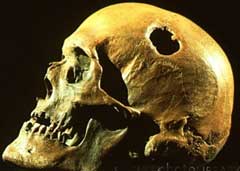
The well-preserved
skull of Gadevang Man, a prehistoric 'bog body', dated 480-60 BC, found
in Denmark (Left). The skull shows signs of surgical trepanning.
The precise cuts that can be seen on some of the
trephined skulls, and the re-growth of the bone (which proves that the
patient/victim survived the operation), indicate that prehistoric
people had the ability and knowledge to be
successful surgeons.
"This operation involves the removing of one
or more parts of the skull without damaging the blood vessels, the
three membranes that envelope the brain � the dura matter, pia mater
and arachnoid � or the actual brain; not surprisingly, it is a
procedure that requires both skill and care on the part of the
surgeon" (Rudgely 1999, p-126).
Out of 120 prehistoric skulls found at
one burial site in France dated to 6500 BC, 40 had trepanation holes.
Surprisingly, many prehistoric and pre-modern patients had signs of
their skull structure healing; suggesting that many of those that
proceeded with the surgery survived their operation.
(1)
Extract: 'Archaeologists have found
trepanned skulls dating from the late Neolithic, some 5,000 years
ago. Now a team of French and German researchers has suggested
that the procedure goes back even further, to at least 7,000 years
ago.
The evidence comes from the French village of Ensisheim. To date,
archeologists there have unearthed 45 graves containing 47
individuals. One grave held the remains of a 50-year-old man who
had two holes in his skull. Both holes were remarkably free of
surrounding cracks and were clearly the result of surgery, not
violence. One hole, in the frontal lobe, is about 2.5 inches wide;
the second, at the top of the skull, is about an inch wider.
Most questionable trepanations are rather small, and with some you
cannot tell the shape of the original hole that was made within
the skull, or whether it was a fracture, says archaeologist Sandra
Pichler of Freiburg University in Germany, a member of the team.
But in our case you can still see the very straight, slanting
edges of the larger trepanation, and this is artificial. There is
no natural explanation for a hole like that.
Both holes had time to heal before the man died--the smaller hole
is completely covered over with a thin layer of bone; the larger
is roughly two-thirds covered--and neither shows signs of
infection. So they must have had a very good surgeon, and there
must have been some way or another of avoiding infection, Pichler
says. Pichler and her colleagues estimate that it would take at
least six months, and perhaps as much as two years, for such
extensive healing. Since the two holes did not heal to the same
degree, it�s likely they were made during two separate operations.
The team doesn�t know why the man was operated on. Nor can they be
sure exactly how the trepanations were performed, although the cut
marks indicate that the bone was removed by a mixture of cutting
and scraping. Stone Age tools were certainly up to the task: flint
knives are actually sharper than modern scalpels.
The trepanations were done so perfectly that this can�t be the
oldest one, Pichler says. They must have practiced somehow, and
the knowledge of how to do this kind of operation must have been
passed down, Pichler says. The fact that there are two
trepanations is further corroboration: if there had been just one,
you could say that they were lucky. But if you survived two such
operations, your surgeon must have known what he was doing'.
Ref:
http://discovermagazine.com
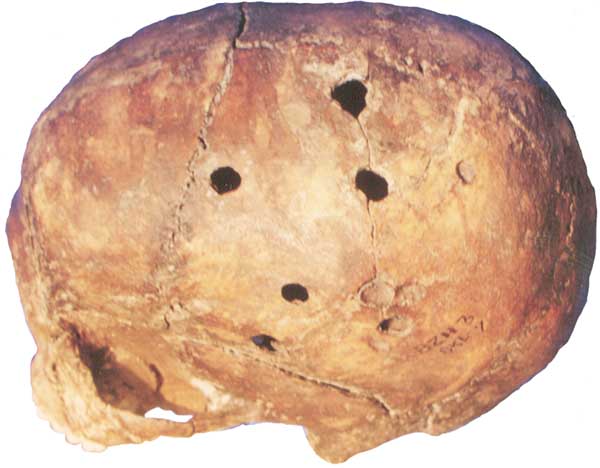 Trepanation
in the Indus Valley culture: The skull on the right was found in a
Harrapan setting, circa 4,000 B.P. The link below leads to
fascinating article describing a Neolithic skeleton with multiple-trepanated
skull found in Kashmir, the archaeological circumstances of the find,
the dating, the background, the skeletal evidence, the details of the
trepanation and possible affiliations to the Indus civilization. It
speculates briefly about possible medical grounds for the surgery. Trepanation
in the Indus Valley culture: The skull on the right was found in a
Harrapan setting, circa 4,000 B.P. The link below leads to
fascinating article describing a Neolithic skeleton with multiple-trepanated
skull found in Kashmir, the archaeological circumstances of the find,
the dating, the background, the skeletal evidence, the details of the
trepanation and possible affiliations to the Indus civilization. It
speculates briefly about possible medical grounds for the surgery.
Ref:
http://www.andaman.org/BOOK/reprints/sankhyan/burzahom.htm
|
Open Heart Surgery.
The
Soviet Academy of Sciences announced in 1969 that a number of ancient
skeletons, found in central Asia showed signs of surgery having been
performed in the area of the heart. Every feature corresponded to what
today is called a 'Cardiac Window', enabling surgeons to perform open
heart surgery.
(9)
|
Article (April,
2012): Beeswax as
Dental Filling on a Neolithic Human Tooth
The finding of a human 6,500 year old partial mandible
associated with contemporary beeswax covering the occlusal
surface of a canine, could represent a possible case of
therapeutic use of beeswax during the Neolithic period in
Slovenia. Although the possibility of treatment of sensitive
tooth structure by means of some type of filling has been
supposed, there is no other published evidence on the use of
therapeutic-palliative substances in prehistoric dentistry. In
ancient Egypt, external applications, composed of honey mixed
with mineral ingredients, were used to fix loose teeth or to
reduce the pain, as reported in the Papyrus Ebers, dating back
to the XVI century BC. (Source:
http://www.plosone.org)
Article: MSNBC (2006) - Proving
prehistoric man�s ingenuity and ability to withstand and inflict
excruciating pain, researchers have found that dental drilling dates
back 9,000 years.
Primitive dentists
drilled nearly perfect holes into live but undoubtedly unhappy patients
between 5500 B.C. and 7000 B.C., an article in Thursday�s issue of the
journal Nature reports.
Researchers carbon-dated at least nine skulls with 11 drill holes found
in a Pakistan graveyard.
That means dentistry is
at least 4,000 years older than first thought � and far older than the
useful invention of anaesthesia.
(Ref:
http://www.msnbc.msn.com/id/12168308/)
(Extract from 'THE TIMES', Thurs April 12th 2001).
Prehistoric dentists may have been using stone drills to treat tooth decay
up to 9,000 years ago, a team of archaeologists has discovered.
Excavations at a site in Pakistan have unearthed skulls containing teeth
dotted with tiny, perfectly round holes. Under an electron microscope,
they revealed a pattern of concentric grooves, that were almost certainly
formed by the circular motion of a drill with a stone bit.
The
discovery, which was made at an archaeological dig in Mehrgarh, in
Baluchistan Province, offers the earliest evidence of human dentistry.
The
excavated village belonged to a civilisation that thrived between 8,000 and
9,000 years ago, whose members cultivated crops and made jewellery from
shells, amethyst and turquoise.
Andrea
Cucina, of the University of Missouri-Columbia, who found the molars with
telltale marks, said: �At this point we can�t be certain, but it is very
tantalising to think they had such knowledge of health and cavities and
medicine to do this�.
Dr
Cucina, whose research is reported in New Scientist magazine, said the
holes would probably have been filled with some sort of medicinal herb to
treat tooth decay. Any filling would long ago have decomposed.
The
dental discovery was made while Dr Cucina was washing teeth from the
Mehrgarhing and spotted the tiny hole in the biting surface of a molar.
The hole was too perfectly round to have been caused by bacteria and the
tooth had been found in a jawbone, ruling out the possibility that it had
been pierced to be strung on to a necklace.
The Top
of the hole was rounded from chewing, suggesting that it was made while
the owner was still alive.
(Examples
of Prehistoric Drilling)
|
Prehistoric Egyptian Surgery: |
In ancient Egyptian medicine the skills and
knowledge of doctors developed from the legacy of the prehistoric
age. Doctors in ancient Egypt were usually also priests, and
religious rituals continued to be used alongside rational
treatments as both were believed necessary for a cure. Important
deities invoked in medicine included Imhotep, the god of healing,
who was formerly doctor to Pharaoh Zoser in the 3rd millennium
BC, and Thoth, god of wisdom and learning.
A system of medical training was established in the temples and a
written language developed using hieroglyphics. Medical treatments
were recorded on papyri such as the Papyrus Ebers and the Papyrus Edwin Smith. The standard work used by Egyptian
doctors was the Book of Thoth, a collection of ritual and
rational treatments. The religious practice of mummification, in
which the organs of the body were removed, helped Egyptian doctors
to gain an understanding of human anatomy, although dissection was
banned for religious reasons. However, Egyptian doctors began to
practise basic surgery such as the removal of growths on the skin
or cataracts from the eyes. Egyptian doctors believed that illness
was often caused by the body's channels becoming blocked because
of rotting food in the stomach, a practical theory based on their
observation of the River Nile. Patients affected were given
emetics to make them vomit or laxatives to loosen their bowels and
clear the blockage.
Ref:
http://encyclopedia.farlex.com
Article: (Oct, 2012) - 'MessageToEagle.com'.
'Evidence of
Sophisticated Prosthetics in Ancient Egypt'
'In
1996, scientists discovered that the 2600-year-old mummy of an
Egyptian priest Usermontu in the Rosicrucian Egyptian Museum
drew a worldwide attention when an x-ray revealed an ancient
nine-inch metal screw connecting the mummy's thigh and lower
leg. And according to Dr. Richard Jackson, orthopedic surgeon
for BYU's athletic team, the pin was made with a lot of
biomechanical things we still use to make sure we get good
fixation in stabilizing bone! Now, the results of scientific
tests using replicas of two ancient Egyptian artificial toes,
including one that was found on the foot of a mummy, suggest
that they�re likely to be the world�s first prosthetic body
parts'.
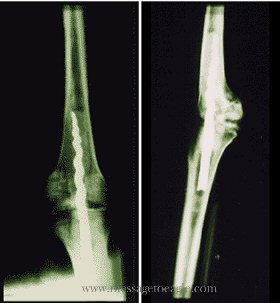
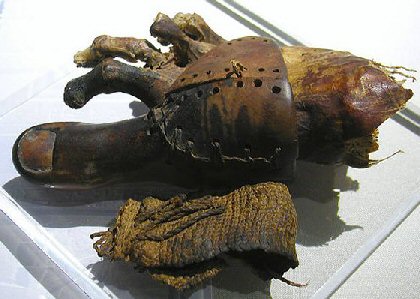
Images of 2600
year old Egyptian surgical screw (left) and prosthetic toe (right).
(Link
to Full Article)
Circumcision:
Circumcision might
well be claimed to be the most ancient 'elective' operation and was
practiced in Ancient Egypt by assistants to the priests on the priests
and on members of Royal Families. There is remarkable evidence for
this carved on the tomb of a high ranking royal official which was
discovered in the Saqqara cemetery in Memphis and is dated between
2400 and 3000 BC.
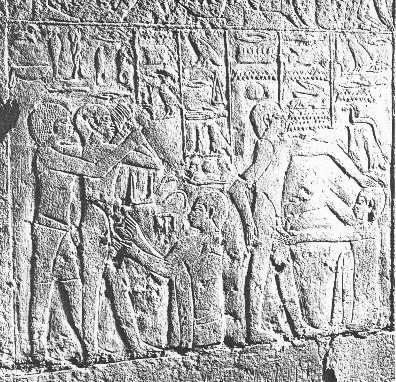
This represents two
boys or young men being circumcised. The operators are employing a
crude stone instrument. While the patient on the left of the relief is
having both arms held by an assistant, the other merely braces his
left arm on the head of his surgeon. The inscription has the operator
saying 'hold him so that he may not faint' and 'it is for your
benefit'. (2)
(Ancient
Egypt Homepage)
|

 Trepanation
in the Indus Valley culture: The skull on the right was found in a
Harrapan setting, circa 4,000 B.P. The link below leads to
fascinating article describing a Neolithic skeleton with multiple-trepanated
skull found in Kashmir, the archaeological circumstances of the find,
the dating, the background, the skeletal evidence, the details of the
trepanation and possible affiliations to the Indus civilization. It
speculates briefly about possible medical grounds for the surgery.
Trepanation
in the Indus Valley culture: The skull on the right was found in a
Harrapan setting, circa 4,000 B.P. The link below leads to
fascinating article describing a Neolithic skeleton with multiple-trepanated
skull found in Kashmir, the archaeological circumstances of the find,
the dating, the background, the skeletal evidence, the details of the
trepanation and possible affiliations to the Indus civilization. It
speculates briefly about possible medical grounds for the surgery.

